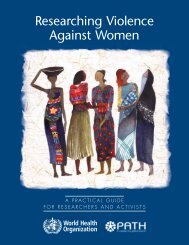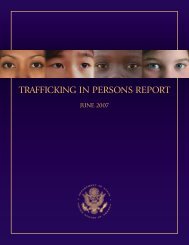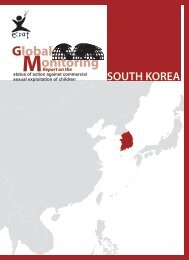Download PDF - Violence Against Children - East Asia and the ...
Download PDF - Violence Against Children - East Asia and the ...
Download PDF - Violence Against Children - East Asia and the ...
You also want an ePaper? Increase the reach of your titles
YUMPU automatically turns print PDFs into web optimized ePapers that Google loves.
Vietnam<br />
• At <strong>the</strong> community level, World Vision<br />
Vietnam develops strong day-to-day<br />
working relationships with local families,<br />
<strong>the</strong> ones who will benefit directly from <strong>the</strong><br />
program. Key in this process is <strong>the</strong> role of<br />
community volunteers who are trained <strong>and</strong><br />
supported by World Vision. This allows for<br />
deeper impact <strong>and</strong> <strong>the</strong> development of<br />
human resources in <strong>the</strong> community, which<br />
will be available after <strong>the</strong> project finishes.<br />
Impact of <strong>the</strong> project<br />
Evaluations of World Vision Vietnam’s<br />
community-based rehabilitation work have<br />
indicated that:<br />
• Increased knowledge… <strong>and</strong> awareness<br />
of disability has been noted in <strong>the</strong> families<br />
of children with disabilities, <strong>the</strong> community<br />
<strong>and</strong> <strong>the</strong> government. Prior to <strong>the</strong> project,<br />
people had a low awareness of how to<br />
assist children with disability. Their<br />
definitions showed little underst<strong>and</strong>ing of<br />
“disability” beyond restricted movement or<br />
seeing/hearing difficulty; intellectual or<br />
psychiatric conditions were not in <strong>the</strong>ir<br />
category of disability. Now, <strong>the</strong>re is greater<br />
underst<strong>and</strong>ing; for example, family<br />
members <strong>and</strong> o<strong>the</strong>rs in <strong>the</strong> community<br />
underst<strong>and</strong> that many children with<br />
disabilities need to receive nutritional<br />
attention. These changes in thinking <strong>and</strong><br />
attitudes were all made possible through<br />
various training approaches that have been<br />
provided.<br />
• Increased ownership… has followed<br />
increased awareness. Service providers<br />
<strong>the</strong>mselves wanted to do more, but<br />
increased motivation in <strong>the</strong> communities to<br />
assist children with disabilities has led to<br />
requests for support from World Vision.<br />
This is significant, because previously it was<br />
usually World Vision approaching <strong>the</strong><br />
community to provide assistance or plan<br />
activities for <strong>the</strong>se children. There has also<br />
been greater contribution from local<br />
government agencies to <strong>the</strong> project.<br />
• Increased options… have meant that<br />
local government officers, volunteers, CBR<br />
workers, <strong>and</strong> <strong>the</strong>ir family members now<br />
have a range of ways to help children who<br />
have disabilities. Prior to <strong>the</strong> project, local<br />
responses would typically see such children<br />
(if <strong>the</strong>y were responded to at all) removed<br />
from <strong>the</strong> family home <strong>and</strong> sent to <strong>the</strong><br />
hospital, to be provided with medicine or<br />
physical rehabilitation. Now, building on <strong>the</strong><br />
knowledge that children with disabilities<br />
need to – <strong>and</strong> can – go to school, have<br />
friends, go outside, <strong>and</strong> enjoy fresh air,<br />
communities provide greater options for<br />
<strong>the</strong>se children to fulfil <strong>the</strong>ir need for social,<br />
mental <strong>and</strong> educational rehabilitation.<br />
• Increased quality of life… has been<br />
evident in <strong>the</strong> children <strong>the</strong>mselves. Some<br />
have made progress in mobility. Equally or<br />
more importantly, many have become<br />
outgoing, no longer afraid of meeting<br />
people o<strong>the</strong>r than <strong>the</strong>ir family members.<br />
Some children’s speech impairments have<br />
improved, as <strong>the</strong>y have had more visitors,<br />
volunteers <strong>and</strong> local government officers to<br />
communicate with. The involvement of<br />
<strong>the</strong>se people is stimulating for children, as<br />
it reflects interest in/valuing of <strong>the</strong>m by<br />
o<strong>the</strong>rs. <strong>Children</strong> respond to this with<br />
increased levels of energy, engagement <strong>and</strong><br />
enquiry. Their voices are now heard –<br />
encouraging o<strong>the</strong>rs, or speaking on issues<br />
that affect <strong>the</strong>m. Through modelling<br />
approaches, World Vision encourages <strong>the</strong><br />
local government to take on this issue by<br />
training <strong>and</strong> involving volunteers.<br />
• Specific influence on public policy for<br />
provision of services to children has<br />
occurred. Vietnam’s policy is that <strong>the</strong> state,<br />
society <strong>and</strong> community will provide health<br />
care, support for foster care, education,<br />
cultural activities, physical training <strong>and</strong><br />
sport, <strong>and</strong> that public buildings will be<br />
accessible for people with disability. Specific<br />
applications of <strong>the</strong> policy are not always<br />
apparent, however: building designs do not<br />
take disability into account. On <strong>the</strong> o<strong>the</strong>r<br />
h<strong>and</strong>, hospitals do often exempt poor<br />
children with disabilities from, or give <strong>the</strong>m<br />
discounts on, <strong>the</strong> costs of medical services.<br />
78

















